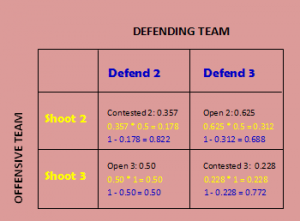Game Theory in late-game situations – to shoot a 3 or 2?
In basketball, many games are decided by one basket or less. When it gets down to the wire, often teams are faced with this scenario: one team will be down by 2 points and have the last shot. They can decide either to shoot a two-pointer and send the game into overtime, where 5 extra minutes are added onto the clock, or shoot a three-pointer and win the game. Clearly here we have a zero-sum game with two players – an offense and a defense, two strategies – shoot the two or three (defend the two or three for the defense), and various payoffs. Using late-game statistics recorded over many years in the NBA, Mercyhurst University’s Shawn Ruminski applied game theory to analyze which strategy each team should use when faced with this situation (http://mindyourdecisions.com/blog/2012/06/19/game-theory-applied-to-basketball-by-shawn-ruminski/).
To create his payoff matrix, Ruminski used field-goal percentages (how often a shot goes in) for open and contested twos and threes. If the attacking team decides to shoot a three while the defense guards the two, the offense will get an open three, and vice versa. If the attacking team decides to shoot a three while the defense guards the three, the offense will shoot a contested three. Here are the 4 statistics Ruminski used – open 2 pt. FG% (from eFG%): 62.5%; open 3 pt. FG%: 50.0%; contested 2 pt. FG%: 35.7%; and contested 3 pt. FG%: 22.8%. The following matrix was constructed (with payoffs color coded):
The matrix confirms that there is no dominant strategy or pure Nash Equilibrium for each team; so, Ruminski went ahead and calculated the Mixed Strategy Nash Equilibria. If we define p as the probability that the offense shoots a 3, and q as the probability the defense defends the 3, then the Mixed NE says that the offensive team should shoot the three 33.0% of the time, while the defensive team should defend the three 79.3% of the time. This way, neither team’s strategy can be exploited.
Obviously, this is a huge oversimplification of last-possession situations. The shooting percentages that Ruminski acquired will never fully capture the true shooting percentage of a player game by game, shot by shot. Every shot is different, and can be affected by who is guarding the shooter, where on the court the shot is taken, and even factors like crowd noise, fatigue level, etc.
Regardless, Game theory and other statistical analyses are revolutionizing the way we play and view sports. Ruminski used simple Mixed Strategy NE analysis to determine what teams should generally do in late-game situations. He found that a team down 2 with the ball should only attempt a 3 a third of the time, while a defensive team in that scenario should almost always defend the three and accept the opposing team knocking down a two-pointer. But sometimes, when you’ve got a guy named Lebron James on your team, you’ve just got to ignore the analytics and give him the ball. Enjoy.

